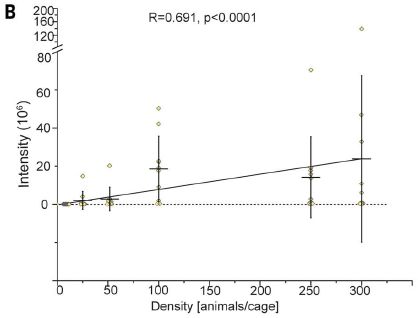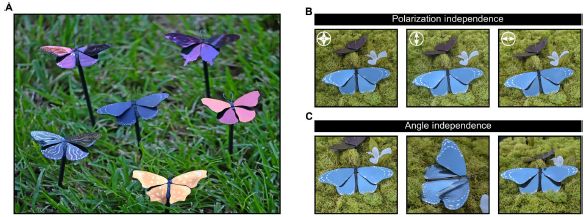Home
> Musings: Main
> Archive (this is first Archive page)
| Introduction
| e-mail announcements
| Contact
Musings: May - December 2023 (archive)
Musings is an informal newsletter mainly highlighting recent science. It is intended as both fun and instructive. Items are posted a few times each week. See the Introduction, listed below, for more information.
If you got here from a search engine... Do a simple text search of this page to find your topic. Searches for a single word (or root) are most likely to work.
If you would like to get an e-mail announcement of the new posts each week, you can sign up at e-mail announcements.
Introduction (separate page).
This page:
2023 (May - December)
In the new "Updates" mode:
December
November
October
September
August
Regular Musings posts:
June 28
June 21
June 14
June 7
May 31
May 24
May 17
May 10
May 4
Also see the complete listing of Musings pages, immediately below.
All pages:
Most recent posts
2024
2023:
January-April
May - December: this page, see detail above
2022:
January-April
May-August
September-December
2021:
January-April
May-August
September-December
2020:
January-April
May-August
September-December
2019:
January-April
May-August
September-December
2018:
January-April
May-August
September-December
2017:
January-April
May-August
September-December
2016:
January-April
May-August
September-December
2015:
January-April
May-August
September-December
2014:
January-April
May-August
September-December
2013:
January-April
May-August
September-December
2012:
January-April
May-August
September-December
2011:
January-April
May-August
September-December
2010:
January-June
July-December
2009
2008
Links to external sites will open in a new window.
Archive items may be edited, to condense them a bit or to update links. Some links may require a subscription for full access, but I try to provide at least one useful open source for most items.
Please let me know of any broken links you find -- on my Musings pages or any of my web pages. Personal reports are often the first way I find out about such a problem.
Updates (August - December)
No further regular posting of new items is planned, as noted below: Announcement (June 28, 2023).
Occasional brief notes may be added, usually as "updates" to previous posts. In general, an update will be at the end of the original post. Such items will be noted here, but no e-mail announcement is planned. Comments on how this is done are welcome.
Here are the first such "updates"...
December 2023
Added December 15, 2023.
See Underground hibernation in primates? (October 6, 2013). Ekgmowechashala: a lemur-like primate in America.
Added December 11, 2023.
See Reactivating fetal hemoglobin production to treat β-hemoglobin problems - II (February 16, 2021). The US FDA has approved two gene therapy treatments for sickle cell disease. One uses CRISPR, along the lines of what was discussed in this earlier post.
Added December 7, 2023.
See Formation of the moon: was the Earth surface molten? (June 16, 2019). A new article reports evidence for remains of Theia on Earth.
November 2023
Added November 30, 2023.
See CRISPR: an overview (February 15, 2015). And now, CRISPR-like enzymes -- called Fanzors -- in eukaryotes.
Added November 16, 2023.
See The Iceman's blood (May 14, 2012). A new genome sequence for this famous "natural" mummy -- and a lesson in genome quality.
Added November 13, 2023.
See Solar energy: What if the Moon got in the way? (August 16, 2017). More about the recent eclipse, with an additional picture. This is added there to the update of October 20, 2023.
Added November 9, 2023.
See A phage treatment for inflammatory bowel disease (August 13, 2022). New systematic clinical work with phage therapy for a range of pathogens is promising.
Added November 3, 2023.
See Venus flytrap; converting defense into offense (July 27, 2016). A new article reports using CRISPR to learn more about catching insects.
October 2023
Added October 27, 2023.
See: Paint without pigment (May 4, 2023). Paint developments continue, with a paint that does photosynthesis.
Added October 20, 2023.
See Solar energy: What if the Moon got in the way? (August 16, 2017). Our solar eclipse this past weekend was an annular eclipse. The update links include video of the event, as well as information.
Added October 13, 2023.
See Loss of ability to taste "sweet" in carnivores (April 6, 2012). This post starts with noting that cats do not taste "sweet"; further, they lack receptors for "sweet". New work explores why cats like tuna.
Added October 5, 2023.
See Briefly noted... mRNA vaccine history (November 3, 2021). The development of mRNA vaccines has been recognized by the ...
September 2023
Added September 29, 2023.
See Data on 31 isotopes of cadmium support a new model for the structure of atomic nuclei (December 1, 2018). Scientists have made oxygen-28. Its extreme instability is not consistent with current views on nuclear structure.
Added September 25, 2023.
See Beethoven's genome (June 26, 2023). Another news story, this one of special interest.
Added September 12, 2023.
See A clue about cancer from the naked mole rat? (January 18, 2014). A gene that increases lifespan in naked mole rats has now been transferred to lab mice.
August 2023
Added August 30, 2023.
See Sleep stages in octopuses -- do they dream? (July 13, 2021). More about "sleep" in octopuses.
Added August 18, 2023.
See Beethoven's genome (June 26, 2023). A bit of Beethoven's skull has become available for research.
July 2023
(none)
June 28, 2023
Announcement
June 28, 2023
This is the final set of Musings posts -- at least for now.
This set completes 15 years of Musings, with 2,852 posts. (As discussed before, those numbers are not as precise as they sound. But they give an idea.)
I will continue to do light maintenance, at least for a while. So do let me know of problems. That includes text errors, things that are not clear, and science issues. If there is a new development that might change the perspective, let me know. That includes retractions. It is fundamental that science is always "in progress".
I will likely add occasional updates to some posts, with new findings that are interesting. I will provide a list of such updates at the top of this page, but plan no routine notifications of them.
The future? Probably none, but I will think about it, perhaps after a year.
Thank you to all!
And now, the parrots get the last word...
Briefly noted... How parrots use social media
June 27, 2023
Given the opportunity, parrots will call their friends using a video conferencing system. So says a recent article; it is from MIT, Parrot Kindergarten, and other institutions. The scientists asked not just whether the parrots will use the system, but whether they benefit from it. The work is an exploration of parrot sociology; it may be of benefit to birds often kept as pets with little interaction with other birds.
* News stories:
- Squawk! You there? Pet parrots video call each other to elevate social lives -- The study parrots engaged in various social behaviors that researchers would often see amongst groups of birds or in the wild, including dancing and singing together. (Baba Tamim, Interesting Engineering, April 30, 2023.)
- Video-calling tech could help lonely parrots flock together. (University of Glasgow, April 21, 2023.)
* The article, which is open access: Birds of a Feather Video-Flock Together: Design and Evaluation of an Agency-Based Parrot-to-Parrot Video-Calling System for Interspecies Ethical Enrichment. (Rebecca Kleinberger et al, Proceedings of the 2023 CHI Conference on Human Factors in Computing Systems (CHI '23), April 23-28, 2023, Hamburg, Germany.) This is a meeting presentation. Whether the posted article is peer-reviewed, I don't know. One of the authors is affiliated with the Parrot Kindergarten, in Florida, which was the source of many of the parrots used in this study. These birds were already familiar with on-line interaction.
* There are two video files posted with the article. Both describe the work; they are somewhat redundant. I suggest you start with the first one ("video-figure"; 6 minutes), which is shorter and maybe clearer. It seems intended as a video-file presentation. The second ("talk-video"; 9 minutes) is a version of the meeting presentation.
* Alos see: The genetic basis of why parrots seem so human (March 31, 2019).
Beethoven's genome
June 26, 2023
A team of scientists -- with 28 author affiliations from three continents -- has reported the genome sequence for Ludwig van Beethoven. Actual conclusions are soft, but what they did is a fun story.
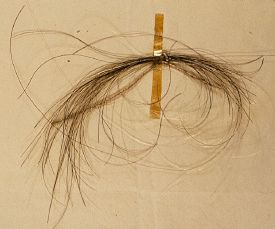
|
The Stumpff Lock. It is a lock of hair from Beethoven. It is attached to a letter.
A small portion of this hair was one source of DNA.
The letter is from Johann Andreas Stumpff to Patrick Stirling, dated May 7, 1827 (about a month after Beethoven's death).
This is part of Figure 3 from the article. The full figure shows the letter, with a translation in the figure legend.
|
|
|
The scientists worked through several possible DNA sources, trying to evaluate the authenticity of each. They ended up with five hair samples with (largely) independent histories that they were sure were from Beethoven. When analyzed, all contained the same genome, showing that they are from the same person. That is, the identification of the genome as Beethoven's builds on multiple, substantially independent, lines of evidence. The discussion of the history of the samples is an interesting aspect of the article.
Beethoven had multiple health problems, and expressed the desire that history might figure them out. Perhaps the best known problem was his hearing loss. The analysis of his genome reported here offers no clues about the hearing loss. However, it does uncover mutations that likely promoted liver disease. The scientists also found sequences of hepatitis B virus in one hair sample. Historical records are inconsistent in describing the level of Beethoven's alcohol consumption. But the genetic factors, along with a liver virus and possible excessive alcohol, might all have contributed to the liver disease that was the likely cause of his death.
Although the primary story in the article is using Beethoven's genome to address his health issues, a couple of other points worth noting came out.
The work on authenticating the hair samples yielded another piece of information -- based on a negative finding. Previous work had suggested lead exposure, based on a hair sample. The current work, establishing the clear history of each sample, showed that the hair sample in question was not from Beethoven. Thus there is no evidence that lead poisoning was relevant, for his hearing loss or any other issues.
The genome analysis also uncovered another little story... Beethoven's ancestry is well-recorded back to Aert van Beethoven (1535-1609), his great-great-great-great-great grandfather. Other descendants of Aert are known, with documented details of ancestry. Five such males were also analyzed here. Interestingly, the Y chromosomes, signature of the male lineage, do not match. The best guess from all the available data is that there was what they call an extra-pair-paternity (EPP) event somewhere between Aert and Ludwig.
The article is an interesting application of modern DNA sequencing technology to an aspect of history.
News stories:
* DNA From Beethoven's Hair Reveals Clues About His Death -- The composer was predisposed to liver disease and had hepatitis B at the end of his life, a new study finds. (Will Sullivan, Smithsonian, March 23, 2023.)
* Beethoven's DNA -- Scientists have sequenced Beethoven's genome from locks of his hair, revealing clues to the composer's health and family history. (Tom Almeroth-Williams, University of Cambridge, March 22, 2023.) Excellent overview; lots of good pictures.
The article, which is open access: Genomic analyses of hair from Ludwig van Beethoven. (Tristan James Alexander Begg et al, Current Biology 33:1431, April 24, 2023.) (The author list contains a famous distinctive family name. The current author is the son of the 97-year-old naturalist so familiar from television.)
Thanks to Greg for sending the article, along with some comments that got us started on the post.
My page Internet resources: Miscellaneous includes a section on Art & Music. There is a list of related Musings posts; it includes two other posts noting Beethoven in the title.
There is more about genomes on my page Biotechnology in the News (BITN) - DNA and the genome. It includes an extensive list of related Musings posts.
Update added September 25, 2023.
Another news story about this -- especially interesting because Beethoven made the cover of a scientific journal.
* News story: About the Cover: B for Beethoven. (Terence Chorba, Emerging Infectious Diseases 29:1948, September 2023.) The original article of this post, above, is reference 2 of this news story.
Update added August 18, 2023.
A piece of skull, allegedly from Beethoven, has been donated to the Medical University of Austria, where it will be displayed -- and studied. The skull piece has been known for many years, but it has not been public. Its authenticity has been unclear. The first step will likely be to try to establish its authenticity, using the genome information discussed above.
* News story: Skull Fragments Thought to Be Beethoven's Return to Vienna. (Teresa Nowakowski, Smithsonian Magazine, July 28, 2023.)
* Thanks to Greg for sending this update.
Briefly noted... Cultured meat: the environmental cost
June 24, 2023
Animal cell-based meat (ACBM) refers to meat made artificially, using animal cells grown in a reactor. It is also referred to as cultured meat. A new article, currently under peer review, offers a life cycle assessment (LCA) of the process. The main finding is that cultured meat is not environmentally friendly: it has a huge cost in terms of greenhouse gas emissions (e.g., CO2). This is not the first LCA for the process, but it is probably the most negative. Why? It is more detailed, and includes the cost of the ingredients for growing the cells. It focuses on processes for cultured meat that are in actual use. (The authors note that some of the more optimistic analyses use hypothetical scenarios that have not even been used at lab level, and which may have serious limitations.) The article raises issues that need to be addressed.
* News stories:
- Lab-grown meat's carbon footprint potentially worse than retail beef, finds study. (Phys.org (Amy Quinton, UC Davis), May 22, 2023.) Good overview of the issues.
- Cultivated meat could emit 25 times more CO2e than conventional beef, finds research. (Flora Southey, Foodnavigator.com (Europe), May 23, 2023.) (CO2e? That is CO2 equivalents.)
* The article, which is currently available as a preprint prior to peer review; it is open access: Environmental impacts of cultured meat: A cradle-to-gate life cycle assessment. (Derrick Risner et al, bioRxiv, April 21, 2023.) Much of the article is very readable, as an overview of the approaches and other such analyses that have been done. The actual analyses are quite technical.
* Also... The article refers to a new related article from the same group: Risner et al, 2023. It is listed as Nature Foods, in press. Here is a preprint (prior to peer review); it is open access: Cradle to production gate life cycle assessment of cultured meat growth media: A comparison of Essential 8TM and Beefy-9. (Derrick Risner et al, bioRxiv, April 21, 2023.) (Will the published article be open access? I don't know.)
* Background: Growing meat without an animal? (April 11, 2018). Links to more.
June 21, 2023
Briefly noted... Human origins -- more complexity
June 21, 2023
Humans arose in Africa. It has been assumed that there was a single ancestral population in Africa -- for lack of data to the contrary. A new article provides data to the contrary. The key work is an extensive analysis of genomes from various modern African populations. Large-scale genome analysis is always complex, with conclusions largely from computer modals. But the results suggest that there have long been multiple distinct populations in Africa, with some genetic mixing. The human scene prior to migration out of Africa was more complex than we had thought. As so often, having more data suggests a more complex model -- one that is probably more realistic, but still just a model.
* News stories:
- A new understanding of human origins in Africa. (Phys.org (McGill University), May 17, 2023.)
- Unraveling the origins of humanity: New research challenges single-origin theory. (Bhavana Kunkalikar, News-Medical.net, May 21 2023.) More detailed.
* The article, which is open access: A weakly structured stem for human origins in Africa. (Aaron P Ragsdale et al, Nature 617:755, May 25, 2023.)
* An early post on the contribution of genome analysis to understanding the complexity of the human family tree: Contributions of Neandertals and Denisovans to the genomes of modern humans (July 6, 2016).
* There is more about genomes on my page BITN - DNA and the genome. It includes a list of Musings posts.
Wooden transistors
June 20, 2023
A recent article reports an interesting development in electronics technology: a novel kind of transistor.
The following figure shows that it works...
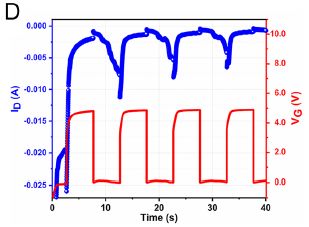
|
The graph shows input and output vs time. The input voltage is shown in red (right-hand y-axis); the output current is shown in blue (left-hand y-axis).
The output current responds to the controlling voltage -- within ten seconds.
This is Figure 3D from the article.
|
That response is the essence of a transistor.
This transistor is operating at 100 mHz. That's millihertz.
The following figure shows the transistor...
The transistor is shown here, held by a person's fingers in front of his face. (Seeing the face is sensitive to viewing angle.)
This is from the news story from the University. There are pictures in the article, and the dimensions are stated. But the photo above is good for sense of scale.
|
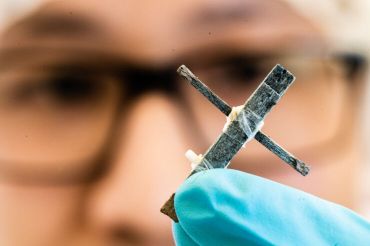
|
It is the first transistor made of wood capable of continuous operation. It is called a wood electrochemical transistor (WECT).
The scientists have been experimenting with the use of wood for electronics for some time. In this new work, they make progress toward controlling the electrical properties.
This is not completely natural wood. The scientists processed the wood to remove much of the lignin, then filled the resulting gaps with a conductive organic polymer.
Why? Why not? The lead authors are in the Laboratory of Organic Electronics and the Wallenberg Wood Science Center, Linköping University (Sweden).
For now, this is just basic research -- "done in the spirit of collaborative curiosity." (From the IEEE Spectrum news story.)
News stories:
* World's First Wood Transistor Chops Out at 1 Hz -- It can't run Doom yet, but it's made from renewable materials. (Mark Tyson, Tom's Hardware, April 29, 2023.)
* Timber! The World's First Wooden Transistor > Balsa-based circuit component could be integrated into living plants. (Dina Genkina, IEEE Spectrum, April 29, 2023.)
* The world's first wood transistor. (Anders Törneholm, Linköping University, April 28, 2023.)
The article, which is open access: Electrical current modulation in wood electrochemical transistor. (Van Chinh Tran et al, PNAS 120:e2218380120, April 24, 2023.)
Related? Using wood-based material for making biodegradable computers (July 21, 2015). Not really. It has nothing to do with wooden electronics. Links to more, broadly about waste issues.
A recent post about wood, which links to more: Transparent wood (March 6, 2021).
Also see: Briefly noted... 2. A new 1980s-quality computer (December 11, 2019).
Plasticosis
June 18, 2023
There is a lot of waste plastic around. There is relatively little good information about its effects.
A recent article provides some good information about the effects of plastic in one species of sea bird in the wild. It may also be a step toward organizing information on the health effects of plastics.
The first figure shows stained tissue slices from the stomachs of three birds...
Blue indicates scarring of tissue from the stomach (more specifically, from the proventriculus). (Staining is for collagen.)
The three specimens are, from the left: healthy, and moderately and severely damaged.
Using a 0-5 grading scale, they are grades 0, 3, and 5.
The birds are flesh-footed shearwaters (Ardenna carneipes).
The scale bars are 100 micrometers.
This is the bottom part of Figure 1 from the article. (The top of the figure lists the criteria for grading.)
|
That grading scale is introduced in this article; it is an important outcome of the work. Tissue slices are analyzed in the lab, and given a score, by an objective scoring system.
Does the score have any significance? The following figure explores that question...

|
The figure shows the grade (y-axis) vs amount of plastic found in the stomach (x-axis, log scale). Each point is for one bird. The grade shown here is the average over multiple tissue samples.
There is a trend: more plastic in the stomach is correlated with more stomach damage (higher grade score).
|
The x-axis label is mysterious. I suspect it is supposed to mean that they used the log10 of the weight of plastic in grams. That is, 1 on the x-axis means 10 g plastic. Note that the regression equation given at the top uses log(x).
The problem hinted at above gets worse with other parts of the figure. There may be errors or inconsistencies in the labeling.
Even though I have some concerns about the graphs, I have no reason to question the general conclusions, at least qualitatively.
This is Figure 6a from the article.
|
The point is that the observed stomach damage, as reflected in the grade, is related to the amount of plastic in the stomach. (It is not claimed that plastic is the only cause of stomach scarring.)
The scientists not only developed a grading scale, but also a word to describe the condition. The birds with stomach scarring due to plastic are said to have plasticosis.
News stories:
* Plasticosis: A new disease caused by plastic that is affecting seabirds. (Phys.org (James Ashworth, Natural History Museum), March 3, 2023.)
* Seabirds that swallow ocean plastic waste have scarring in their stomachs - scientists have named this disease 'plasticosis'. (Matthew Savoca, The Conversation, March 21, 2023.) General perspective. It refers (and links) to two recent articles from the same lab. The second one, referred to as "newest paper ", is the focus of this post.
The article, which is open access: 'Plasticosis': Characterising macro- and microplastic-associated fibrosis in seabird tissues. (Hayley S Charlton-Howard et al, Journal of Hazardous Materials 450:131090, May 15, 2023.)
A post about plastics in humans: Consumption of microplastics by humans: a report and review from WHO (September 23, 2019). A big caution about the whole field. Plastics are diverse in both chemical and physical properties, including size. These things matter.
A general post on plastics, with links to much more: History of plastic -- by the numbers (October 23, 2017).
Briefly noted... Saturn retakes the lead
June 16, 2023
The officially accepted list of known moons for Saturn has recently grown -- by 63. That puts Saturn back in the lead, among Solar System planets. Of course, nothing has changed at Saturn (we assume); it's just that discovery continues.
* News story: Saturn now leads moon race with 62 newly discovered moons. (Alex Walls, University of British Columbia, May 11, 2023.) (62? 63? You'll see both numbers. I suspect that 63 is the final official number -- for now.)
* NASA: Saturn Moons. (NASA, June 14, 2023.) The page is probably updated regularly; it is now (November 2023) organized differently than when I originally listed it.
* No article has yet been published.
* Background: Briefly noted... Now, 92 for Jupiter (February 22, 2023).
June 14, 2023
Briefly noted... Can we make good vaccines and spare the sharks?
June 14, 2023
Squalene is an interesting chemical. It is a terpene, commonly used in vaccines as an adjuvant, to enhance the immune response. The main supply of squalene is shark liver. A recent article offers an alternative. There is a now a process for making a related chemical, called β-farnosene, using yeast. The new article reports making not only squalene but also a variety of related chemicals using that microbial β-farnosene. Testing suggests that some of the new chemicals may even be better than squalene. It's all early, but the article offers the possibility of better vaccines as well as eliminating one need to harvest endangered sharks.
* News stories:
- Synthesizing squalene to reduce need for shark liver oil. (Bob Yirka, Medical Xpress, February 23, 2023.) Good overview of the current work.
- Shark-Sourced Vaccine Ingredient May Be on Its Way Out. (Molly Campbell, Technology Networks, April 4, 2023.) Includes more of the background.
* The article, which is open access: Semi-synthetic terpenoids with differential adjuvant properties as sustainable replacements for shark squalene in vaccine emulsions. (Karl J Fisher et al, npj Vaccines 8:14, February 16, 2023.)
* This post is listed on my page Biotechnology in the News (BITN) -- Other topics in the section Vaccines (general).
Briefly noted... Unusual nervous system in a comb jelly: implications for understanding the animal kingdom
June 13, 2023
The nervous system consists of a set of discrete cells, called neurons. They connect with each other at junctions, called synapses. A recent article reports an animal that doesn't do it that way. Instead, its nervous system consists of a single large, multinuclear cell, called a syncytium. Long ago, scientists considered that possibility, but the evidence supported individual cells. The animal here is a comb jelly (a ctenophore), Mnemiopsis leidyi, one of the simplest animals. It remains to be seen whether what was found here is the norm for the comb jellies, or is even the norm throughout the life cycle of this one. In any case, the work has implications for understanding the evolution of nervous systems, and the relationships between the simplest animals.
* News story: Discovery challenges our understanding of nervous systems and their evolution -- A new article published in Science suggests fundamental differences of nerve net architecture that challenges our previous understanding on the evolution of nervous systems and how they transmit information. (Melanie Burford et al, University of Bergen, April 24, 2023.)
* The article: Syncytial nerve net in a ctenophore adds insights on the evolution of nervous systems. (Pawel Burkhardt et al, Science 380:293, April 21, 2023.)
* Background post on the comb jelly nervous system: A novel nervous system? (July 20, 2014). The article of this earlier post is reference 5 of the current article.
An antidote to the mushroom toxin α-amanitin
June 12, 2023
Amanita phalloides, the death cap mushroom, is deadly. The major toxic ingredient is α-amanitin (AMA), a liver and kidney toxin. The drug treatments available so far are limited and poorly understood.
A new article reports an antidote to AMA. Further, it is an interesting story how the scientists found it.
Let's start with the bottom line...
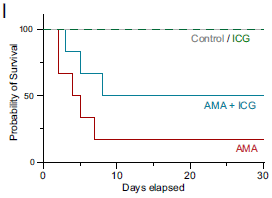
|
The figure shows survival curves for groups of mice.
The bottom (red) curve is for mice given the toxin, AMA. Most died, within ten days.
The curve just above that is for toxin + antidote, AMA + ICG. Better. The antidote doubled the survival in this test.
|
The upper curve is the control. I think it includes two sub-groups, with and without the antidote ICG. The antidote itself seems safe, as judged by this test.
ICG = indocyanine green. It is a chemical well-known in medicine. It was approved several decades ago as a diagnostic agent.
This is Figure 7l (seven-el) from the article.
|
The following figure shows that the benefit of the antidote can be seen in a simpler system...
This test is with mouse liver organoids. There are four conditions, as in the previous figure.
You can see that the toxin, AMA, was bad for growth of the organoids. Adding the antidote substantially reversed the AMA toxicity.
The scale bars are 500 µm (top row) and 100 µm (bottom row). The bars themselves are barely visible, white, at the lower right corner of each row. Most of the healthy organoids are about 500 µm across.
This is Figure 5b from the article.
|
How did they get the antidote? They started with the basics... how does the toxin work? They used CRISPR to knock out individual genes. From that screen, they identified pathways and genes that were needed for AMA toxicity.
One gene, STT3B, seemed of particular interest. (It codes for an enzyme involved in N-glycan synthesis, modifying proteins by adding sugar chains.)
They then screened for inhibitors of the STT3B enzyme -- starting with a collection of FDA-approved small molecules. The first stage of this screening was done "in silico", looking for binding of candidate drugs to the candidate target using computer modeling of the structures. ICG popped out. An inhibitor of a key enzyme needed by AMA. They found something that is promising, and it is already approved by the FDA. The two experiments discussed above were part of the drug characterization that followed its identification as a candidate.
Overall, the work here not only offers a promising lead, but provides some basic background for further drug development.
FDA = US Food and Drug Administration.
What does it mean that the chemical is already approved by the FDA? It has nothing to do with the current proposed use. It just means that, for some reason (use in diagnostics, in this case), the chemical has already been considered by the FDA. There is presumably much known about its pharmacology -- and safety. That prior knowledge can make it easier to get an agent approved for a new specific use. Full data on its effectiveness, and its safety in this context, is still needed.
Just to be explicit... The drug has not yet been tested in humans for the use discussed here. That is perhaps the next step. Direct translation from model organisms to humans is not to be taken for granted. Further, there are plenty of hints that the full situation may be more complex than discussed here. Finding and treating one important step is progress.
News stories:
* Scientists find possible antidote for death cap mushroom poisoning -- Indocyanine green identified using genome-wide CRISPR study and virtual drug screening. (Bethany Halford, C&EN News, May 16, 2023.)
* Possible antidote discovered for deadliest mushroom: study. (Daniel Lawler, Phys.org, May 16, 2023.)
The article, which is open access: Identification of indocyanine green as a STT3B inhibitor against mushroom α-amanitin cytotoxicity. (Bei Wang et al, Nature Communications 14:2241, May 16, 2023.)
More mushrooms and such:
* Are yeasts important partners in lichens? (September 12, 2016)
* Quiz: What is it? (September 23, 2014). Well, this animal looks something like a mushroom.
* SquarePants on Borneo (September 24, 2011)
* Lux aeterna: Mushrooms; Mozart (December 7, 2009)
Effect of climate change on baseball games
June 10, 2023
The following graph shows some data from a recent article...
Part A (left) shows the number of home runs in (US) major league baseball (average number per game; y-axis) vs time (x-axis). The thin line shows data by year. The thick line shows a 10-year moving average.
Part B (right) shows the average temperature (T) at the ballparks over the same time period. The T scale is labeled in °C; a couple of °F values are shown inside.
It's a rough analysis, but the two curves are similar in some ways. Remember, many things, including rule changes, affect the game.
Inside-the-park home runs were excluded when identified. It is likely that many were not identified, but the frequency is so low that it is a minor point.
For the non-baseball people... An ordinary home run occurs when the ball is hit over the fence, within the region of play.
This is part of Figure 1 from the article.
|
The graph suggests a connection between T and home runs. A possible basis for such an effect is clear. Higher T means lower air density, thus allowing the ball to travel further.
That basic finding led to more detailed analysis, using specific paired data. The following figure summarizes the statistical findings; they are presented as percent increase in home runs per degree Celsius increase in T.
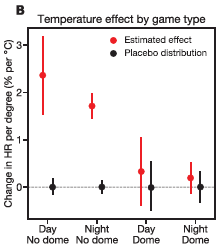
|
For this analysis, the games were divided into four groups: outdoor vs indoor, and day vs night. "Indoor" games are played in domed stadiums, with a roof.
Look at the red points.
The first two points (to the left) are for outdoor games ("no dome"). They both show an estimated effect of about 2% more home rune per degree. The effect may be a bit bigger for day games than night games. That difference is plausible, but the difference shown here is not really statistically significant.
The two points to the right are for indoor games ("dome"). The apparent effect is much smaller, and not statistically significant.
|
The black points are for a "placebo" calculation, using random T values.
For stadiums with retractable domes, an attempt was made to determine whether the dome was open for the game. There was some uncertainty at this step. Overall, that contributes a minor uncertainty to the results.
This is Figure 2B from the article.
|
As noted, baseball is complex. There is no claim that T is the major contributor to the recent increase in home runs. But there is a prediction that it may become more important in the future. A testable prediction.
The article also contains some analysis by ballpark. See Figure 3C in the article.
News stories:
* Climate Change Is Making Home Runs Easier to Hit -- A new study attributes more than 500 homers since 2010 to increased global average temperatures, an effect that will only increase the hotter Earth gets. (Alex Fox, Smithsonian, April 7, 2023.)
* Climate change makes the air hotter, thus less dense, leading to more home runs. (Statistical Modeling, Causal Inference, and Social Science, April 15, 2023.) A blog conversation that starts with some skepticism that the suggested effect is possible. A couple of lines of argument presented end up supporting that the claim is at least plausible. In fact, a physicist had predicted such an effect, of about the observed magnitude, based on the laws of physics. The page is long-winded, but may be fun to browse, at least through the main section (before the 'comments').
* Spike in major league home runs tied to climate change. (Phys.org (Morgan Kelly, Dartmouth College), April 7, 2023.)
The article, which may be freely available: Global Warming, Home Runs, and the Future of America's Pastime. (Christopher W Callahan et al, Bulletin of the American Meteorological Society 104:E1006, May 2023.) The article starts with "Home runs are an exhilarating component of baseball..."; the next paragraph refers to an 1835 article by Clapeyron on the gas laws.
Among posts about baseball:
* Comparing the death rates of American football and baseball players (July 2, 2019).
* The origins of baseball -- two million years ago? (August 18, 2013).
* The Mudville story, on its 125th anniversary (June 3, 2013).
* Baseball and violins (May 15, 2012).
* Baseball physics (July 31, 2011).
June 7, 2023
Briefly noted... Might the doctor's politics affect how they treat COVID?
June 7, 2023
You may have noticed during the COVID pandemic... politics and science/medicine can get intertwined. A recent article addresses the issue with scientific data. As an example, American doctors who identify as politically conservative were more likely to suggest use of the drug hydroxychloroquine to treat COVID-19 than were liberal doctors. This is based on scientific polling, not on data from actual medical records. The broad issue has implications beyond COVID, of course. It's an intriguing article. As always, be careful with interpreting a single article.
* News stories. Note that one of these is the press release from the lead institution; the other is from an independent source that specializes in infectious diseases.
- Political leaning influences doctors' beliefs about COVID treatments, study finds. (Mary Van Beusekom, CIDRAP, February 7, 2023.)
- Political Leaning Shapes Physicians' and Laypeople's Beliefs About COVID-19 Treatments. (University of Pittsburgh, February 6, 2023.)
* The article, which is open access: The political polarization of COVID-19 treatments among physicians and laypeople in the United States. (Joel M Levin et al, PNAS 120:e2216179120, February 8, 2023.)
* Some background on hydroxychloroquine: Does post-exposure administration of hydroxychloroquine prevent Covid-19? A clinical trial (June 16, 2020).
* There is a BITN section for SARS, MERS (coronaviruses). It includes a list of Musings posts in the field.
Using eggshells to make a material for bone grafts
June 6, 2023
Materials for bone replacement are much needed. Natural bone is good, but the useful supply is limited. Much work has been done trying to develop artificial sources, often involving some form of calcium phosphate, the predominant mineral in bone.
A recent article explores the use of egg shells to make a material for bone grafts. Egg shell is largely calcium carbonate, so the shell serves as the calcium source. It also provides trace minerals that may be useful. As a bonus, it makes use of a waste material.
The article reports a wide range of tests of many aspects of the calcium phosphate material made using egg shells. We'll just sample a couple, chosen in part because they are relatively easy to explain.
Most of the tests compare two forms of calcium phosphate made by the scientists. Both are referred to as ACP, for amorphous calcium phosphate. One uses a standard chemical procedure; this is called "Control ACP". The other uses the new eggshell procedure, making "Eggshell ACP".
The first figure shows one test of safety...
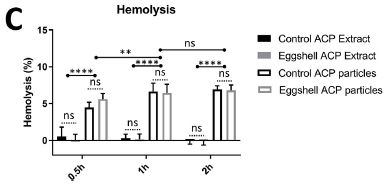
|
This is a test for hemolysis: does the material cause lysis of (human) red blood cells?
There are three sets of data, for three time points, shown on the x-axis.
Each set shows four bars, identified in the key to the right. The first two bars are for extracts from the two materials. The next two are for the materials themselves.
|
Look at the first set, for 0.5 hour. The first two bars, for the extracts, are near zero. The two bars for the materials are near 5%. There is no significant difference between the materials.
That general picture holds for the later time points. There is some increase at 1 h.
The eggshells used in the work were obtained from a company called Balticovo, in Latvia.
This is Figure 4C from the article.
|
The hemolysis seen with the two ACP materials is probably due to sharp edges on some of the pieces (see Figure 2A in the article). In any case, the scientists consider the observed level acceptable.
In addition to developing Eggshell ACP, the scientists developed a test system using 3D cell aggregates with the ACP material. They suggest that their test system, using these osteoblastic spheroids, reflects natural conditions better than prior systems.
The next figure gives an example of the biological effectiveness of the two materials, now embedded in 3D cell aggregates. In this test, they looked at whether the materials induced the activity of genes associated with bone formation ("osteogenic genes"). Gene expression was evaluated by measuring mRNA.

Several such genes were tested over 14 days, The part of the figure above shows results for two genes (labeled at the top of each part), at 14 days. The three graphs in each part are for three media, shown at the bottom.
Start with part S, for the gene OPN. And start with the left graph, for the medium OM.
The first (dark) bar shows the level of gene expression for the control (cells but no ACP). The next two bars (reds) show the level when a calcium phosphate material (an ACP) was included. The middle bar (darker red) is for the "control ACP"; the right-hand bar (lighter red) is for the new eggshell material.
You can see that both ACP materials led to increased gene expression, and that the two types of ACP were about equal. That general pattern holds for part T; in some cases, one or the other ACP seems better.
The label on the y-axis says "Relative mRNA expression vs GAPDH". (GAPDH is a reference gene, assumed to express at constant level.)
This is part of Figure 7 from the article. The full figure includes data for five genes over multiple time points.
|
The overall set of results is complex, but broadly supportive that the eggshell ACP may be useful for supporting bone formation. Figure 9B in the article provides direct evidence that both ACP materials stimulate the production of collagen.
It's hard to know what to make of the work here. At the least, it is an interesting exploration of stimulating bone growth. And it raises the possibility of doing it with egg shells. The test system developed here, using 3D cell aggregates, is probably also of interest.
What's the difference between hydroxyapatite (HAp) and amorphous calcium phosphate (ACP)? Most simply, the crystallinity, which affects the rate of dissolution. That in itself may well be biologically significant in affecting bone development. Further, the ACP materials are more complex chemically, with the details depending on the specifics of how they are made.
News story: Pushing frontiers through upcycling: Eggshell waste for bone graft material. (Phys.org (KeAi, the journal publisher), April 24, 2023.)
The article, which is open access: Eggshell-derived amorphous calcium phosphate: Synthesis, characterization and bio-functions as bone graft materials in novel 3D osteoblastic spheroids model. (Qianli Ma et al, Smart Materials in Medicine 4:522, April 6, 2023.)
More about stimulating bone growth: Need a new bone? Just print it out (November 13, 2016).
There is more about replacement body parts and related topics on my BITN page for Cloning and stem cells. It includes two extensive lists of related Musings posts.
The nanobacteria of Omnitrophota
June 5, 2023
You may not be familiar with Omnitrophota. It is a phylum of bacteria; rather, it would be if it gets officially recognized. So far, no member of the Omnitrophota has been grown in pure culture in the lab; most have not even been seen directly.
The Omnitrophota show up in metagenomic analyses, where one simply analyzes the DNA found somewhere, and infers what chromosomes -- hence organisms -- must be present. There are hints that these are tiny bacteria, which eat "everything", as the phylum name might suggest (omni-troph). They are related, and grouped into a candidate phylum, by their characteristic ribosomal RNA sequences.
A recent article presents the most thorough analysis of the Omnitrophota so far.
The first figure shows the genome sizes...
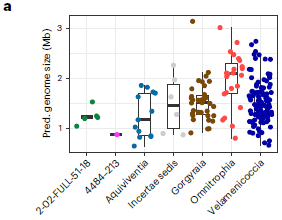
|
The Omnitrophota are shown here divided into seven groups; see the x-axis.
The predicted genome sizes, from the metagenomic analyses, are shown on the y-axis.
The big picture: the genomes are small, even tiny.
The genome of the familiar E coli is about 4.6 megabases (Mb). Only two of the strains shown here have as much as 3 Mb; several have less than 1 Mb.
|
Extended Data Figure 4 (page 22 of the pdf) puts these genome data in the broader context of bacterial genome sizes.
The nature of the seven groups is not important for now. However, we note... They are tentatively considered as taxonomic units at the class level, based on the ribosomal RNA genes. A couple of them have limited data at this point.
This is Figure 1a from the article.
|
The next figure provides some information on cell size...
Each line has two points, one for each of two types of filter. The small-pore filters have 0.2 µm pores (right side); the other filters have 0.45 µm pores (left side).
The full procedure starts with a 1 µm filter. Each sample is filtered sequentially through the three filters, starting with the largest. The analysis is to examine what is collected on the filter, and see what percent of it is Omnitrophota.
(Those are all standard filters. It is commonly assumed that no bacteria would go through either of the two filters shown in the figure).
Many of the lines slope upward, showing that the Omnitrophota were a higher percentage of what was recovered with the smaller pore size.
|
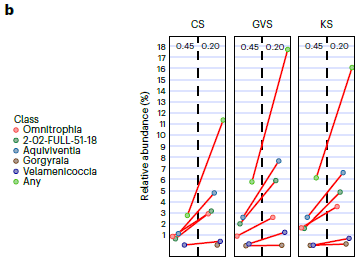
|
These are small cells! Small enough to be worthy of the colloquial term nanobacteria.
The three graphs are for three different sources of spring water.
This is Figure 2b from the article.
|
The genome sequences reveal not only the genome sizes, as shown above, but also the metabolic capabilities. Most of the genomes are streamlined, but they generally seem to have core metabolic genes. Interestingly, genes associated with symbiotic bacteria are common in the Omnitrophota. The scientists suspect that these bacteria live in close association with other bacteria. Perhaps they are unable to grow free-living, or at least to do so well. However, they appear to be very active organisms, just requiring a partner. Of course, that would explain why none of the Omnitrophota have been grown in pure culture in the lab.
The Omnitrophota are quite diverse. We saw diversity with the genome sizes; the specifics of the gene collections suggest diversity of metabolic capability.
The Omnitrophota would seem to warrant much further work. We consider them a group of relatives, based on the similarities of their ribosomal RNA, but beyond that they are very different. However, they will remain hard to study until we learn how to study them along with their hosts.
It is often said that most microbes have not yet been isolated or even identified. The work with bacteria of the not-yet-official phylum Omnitrophota illustrates the problem, and reinforces the importance of solving it.
News stories:
* Study Shines New Light On Ancient Microbial Dark Matter. (Astrobiology (Keith Cowing, University of Nevada, Las Vegas), March 17, 2023.) Don't worry about the complex figure at the top.
* Integrating genomes and qSIP to probe the activity of Omnitrophota -- Weaving between different data types allowed us to integrate otherwise discrete observations and build an incisive and testable picture of this enigmatic phylum. (Cale Seymour, Nature Portfolio Microbiology Community, March 20, 2023. Now archived.) From the lead author of the article. Good for background.
The article, which is open access: Hyperactive nanobacteria with host-dependent traits pervade Omnitrophota. (Cale O Seymour et al, Nature Microbiology 8:727, April 2023.)
A previous post involving metagenomics: The Asgard superphylum: More progress toward understanding the origin of the eukaryotic cell (February 6, 2017). A follow-up post is about the first lab culture of a member of the group, previously known only by metagenomics. Links to more.
There is more about genomes on my page Biotechnology in the News (BITN) - DNA and the genome. It includes a list of Musings posts.
Briefly noted... How fingerprints develop
June 2, 2023
Everyone's fingerprints are unique. A recent article addresses why. It's a complex story, but the scientists have uncovered three regulatory systems that interact to establish the pattern. And that's just a start. Much of the work was done with mice, but key aspects were confirmed in human cell systems. I doubt many will want to work though details here, but the overview is fun. The scientists have addressed and substantially solved an interesting problem.
* News stories. The first two are good readable overviews of the background and what was found.
- Finally, Scientists Uncover the Genetic Basis of Fingerprints -- Much like with a zebra's stripes or a leopard's spots, Turing patterns explain how the distinctive patterns of human fingerprints form, a study finds. (James M Gaines, The Scientist, February 23, 2023.)
- How fingerprints get their unique whorls. (Bob Yirka, Phys.org, February 10, 2023.)
- How do fingerprints develop? (Liji Thomas, News-Medical.net, March 15, 2023.) More technical.
* The article, which is open access: The developmental basis of fingerprint pattern formation and variation. (James D Glover et al, Cell 186:940, March 2, 2023.)
* More about fingerprints: Can one tell if a fingerprint is from a male or a female? (December 4, 2015). Links to more.
May 31, 2023
Briefly noted... Rotation of Earth's inner core
May 31, 2023
The solid inner core of Earth does not rotate exactly as the rest of Earth does. It may rotate a bit faster or a bit slower; it varies. Slower rotation leads to it seeming to rotate backwards -- with respect to the mantle or surface. Reasons for the varying rotation of the inner core are not well understood, but may include magnetic and gravitational effects. Remember, that solid inner core is within a liquid region, so it is not tightly coupled to the upper layers. How do we know how the inner core rotates? Seismic waves provide information on what is inside Earth -- and the reflection patterns seem to be changing. A recent article explores this, with additional data from the archives. It's an interesting story, but a caution... The question and the tools may be of most interest at this point. The answers and explanations are murky.
* News stories:
- Study: Changes in Rotation of Earth's Inner Core Occur on Decadal Scale. (Sci.news, January 24, 2023.) Good overview of the work; includes a diagram of Earth's inner layers.
- Earth's inner core rotating slower than surface, study suggests (Update). (Daniel Lawler, Phys.org, January 24, 2023.) Includes more of the debate about what it all means.
* The article: Multidecadal variation of the Earth's inner-core rotation. (Yi Yang & Xiaodong Song, Nature Geoscience 16:182, February 2023.)
* More about the inner core: Briefly noted... Novel Fe-O compounds in the Earth's inner core? (April 26, 2023).
How locusts avoid cannibalism
May 30, 2023
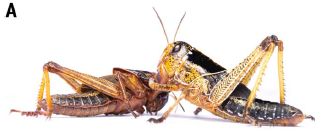
|
A locust eating another.
In the article, events were scored as cannibalism only if the victim was completely consumed.
The locusts here are Locusta migratoria.
This is Figure 1A from the article.
|
One might expect cannibalism to increase as the number of animals in a space increases, simply because they are closer together. One might also wonder if the animals have a defense against cannibalism -- a defense that is active at high densities. A new article addresses the story.
Analysis of the volatile chemicals made by the locusts led to finding a chemical that is repulsive, and thus reduces cannibalism. The following figure shows one of its interesting properties...
In this lab work, the locusts were maintained in uniform cages. Thus the density of animals is manipulated simply by adjusting the number of animals per cage.
The graph shows the production of this chemical (y-axis) vs animal density (x-axis). The results are not clean, but the trend seems significant, both statistically and biologically.
With this set-up, cannibalism begins to appear at densities above about 50 animals per cage. (Figure 1B of the article.)
This is Figure 2B from the article.
|
The overall picture that emerges from the work is that, when crowded, locusts make a volatile chemical that is repulsive, thus effectively reducing cannibalism.
What is the chemical? Phenylacetonitrile (PAN), shown at the right.
This is part of Figure 2A from the article.
|

|
Genetic manipulation to eliminate production of the PAN or to eliminate its receptor had the expected effects.
"An interesting characteristic of these mutant locusts was that they exhibited such a high degree of cannibalism that production in high numbers became extremely hard." (page 6 of the pdf file) That refers to a mutant strain unable to make PAN.
It is another step in understanding the complex life cycle of these insects.
News stories:
* Fine young cannibals: locust study could lead to better pest control -- Discovery of 'anti-cannibalism' pheromone raises possibility of spraying crops with similar chemical as non-toxic insecticide. (Hannah Devlin, Guardian, May 4, 2023.)
* Chemical signal protects migratory locusts from cannibalism. (Phys.org (Max Planck Society), May 4, 2023.)
* News story accompanying the article: The chemical ecology of locust cannibalism -- An anticannibalistic signaling pathway offers a new understanding of locust swarm formation. (Iain D Couzin & Einat Couzin-Fuchs, Science 380:454, May 5, 2023.)
* The article: A chemical defense deters cannibalism in migratory locusts. (Hetan Chang et al, Science 380:537, May 5, 2023.)
More about the chemical ecology of locusts: Understanding locust swarming: a chemical to deal with the problem? (October 13, 2020). Links to more about locusts, including their brains.
More about cannibalism... How to avoid cannibalism (May 25, 2019). Nematode worms. Probably a good survival trait. The article of this earlier post is reference 15 of the current article.
Can ticks transmit CWD prions?
May 28, 2023
CWD = chromic wasting disease, a prion disease of deer and related animals (cervids).
Deer carry ticks, and transmission of ticks between deer is likely, e.g. during grooming. Is it possible that the ticks can transmit CWD -- thus spreading the disease through a herd?
A new article offers some evidence suggesting that they can. Prion diseases are difficult experimental systems, and it is common that actual transmissions are hard to document, but the article makes tick transmission a possibility that should be considered.
The following figure shows one key result...
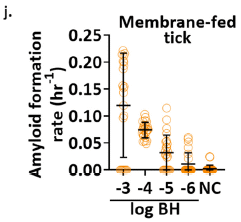
|
In this test, ticks were fed blood containing "brain homogenate" (BH) from infected deer. This was a controlled feeding in the lab, through a membrane; the purpose was to see if ticks can ingest prions from blood. The ticks were then assayed for prions.
Prion level in the ticks was measured by a complex but standard assay, and is reported here as "amyloid formation rate", on the y-axis. The x-axis shows the dilution of the BH; -3 means 10-3, or 1/1000 full strength. The general picture is that prions were recovered from ticks fed blood with BH (that contained prions). And there is a general trend that greater dilution of the BH led to less prion being recovered.
|
NC is for a negative control, with no BH in the blood fed to the tick.
Some of the labeling of the graph is not clear. I am fairly sure that the points made above are correct, but I cannot explain the entire graph.
The ticks studied here are Ixodes scapularis, the black-legged tick.
This is Figure 1j from the article.
|
That result suggests that ticks could acquire prions from the deer they feed on.
The scientists also showed that some of the ticks found on deer in an infected herd do carry prions. That is, what they found in nature agrees with what they found in the lab.
There is no reason to think the prions can replicate in the ticks. Arthropods do not carry a mammalian prion gene, needed for prion "replication". (Remember, ticks are 8-legged; they are arachnids, along with the spiders, not insects.)
There is also no evidence for effective disease transmission from ticks to deer in a natural setting. That would be a very difficult experiment to do. But such disease transmission now seems quite possible -- and that is the point of the article.
News stories:
* Ticks Carry Chronic Wasting Disease and They Could Be Transmitting It to Wild Deer -- New research has found that ticks can ingest "transmission-relevant amounts" of CWD prions and may pose a risk to cervids. (Katie Hill, Outdoor Life, May 22, 2023.)
* Ticks may be able to indirectly spread chronic wasting disease. (Mary Van Beusekom, CIDRAP, May 22, 2023.)
* Ticks found to harbor and release prions of chronic wasting disease. (Pooja Toshniwal Paharia, News-Medical.net, May 17 2023.) Very detailed.
The article, which is open access: Ticks harbor and excrete chronic wasting disease prions. (H N Inzalaco et al, Scientific Reports 13:7838, May 15, 2023.)
Previous post: about CWD: Unusual nature of CWD; implications for transmission to humans (September 24, 2022).
For more about prions, see my page Biotechnology in the News (BITN) - Prions (BSE, CJD, etc). It includes a list of related Musings posts.
Among posts about ticks: An anti-freeze story: Why a tick carries a human pathogen (October 29, 2010).
Update added March 13, 2024.
Can plants serve as carrier in the transmission of prion diseases? A recent article shows that plants can take up prions via their roots, with resulting prion accumulation in the parts of the plant above ground. Mice fed such plants can acquire prion disease. As so often with prion work, the real-world implications are not clear, but this is another example of how hardy prions might spread through the environment. (The work here was done with two lab-adapted prion strains, from transmissible mink encephalopathy and scrapie.)
* News story: Plants can take up CWD-causing prions from soil in the lab. What happens if they are eaten? (Mary Van Beusekom, CIDRAP, February 22, 2024.)
* The article, which is open access: Plants as vectors for environmental prion transmission. (Christina M Carlson et al, iScience 26:108428, December 15, 2023.)
May 24, 2023
Briefly noted... Recycled water: safety
May 24, 2023
Recycled water could be a significant contributor to our water supply. A recent article reports that recycled water is just as clean and safe as standard water sources -- maybe even better. The article is of interest as much for the issues it raises as for the answer, which of course will depend on many details. The article focuses on high quality systems designed for water recycling; that can explain why recycled water may actually be cleaner than standard water. It also discusses what the criteria should be. An important issue is that a standard list of dis-allowed contaminants is not sufficient; some important contaminants have not yet been identified. Their own testing relies on actual biological tests. The article notes that high quality recycled water is probably less expensive than desalinated seawater.
* News stories:
- Treated, recycled wastewater found to be cleaner and less toxic than conventional drinking water samples. (Alexandru Micu, ZME Science, November 16, 2022.)
- Treated wastewater can be more dependable and less toxic than common tap water sources. (Phys.org (Corey Binns, Stanford University), November 14, 2022.)
* News story accompanying the article: Drinking water: Toxicity analysis supports reuse -- Against a backdrop of intense global drought, an innovative method for measuring toxicity to cells has been used to provide further evidence that the quality of potable-reuse water compares well with that from conventional public water supplies. (Martin A Page, Nature Sustainability 6:7, January 2023.)
* The article: Toxicological assessment of potable reuse and conventional drinking waters. (Stephanie S Lau et al, Nature Sustainability 6:39, January 2023.)
* A recent post on water purification: Purifying water using fluorinated nanopores (August 16, 2022).
A new ice, with the density of liquid water
May 23, 2023
If you break a big object into smaller pieces, what is the density of the pieces? Imagine hitting a piece of glass or ice with a hammer. The individual pieces will have the same density as the original big block. Density is a property of the (type of ) material, and does not depend on size.
If someone did such a test and found that the density did not change, it probably would not be worthy of a scientific article. So, beware, we're up to something.
The work starts with ordinary ice, which is treated to break it into small pieces. Look at what happens...
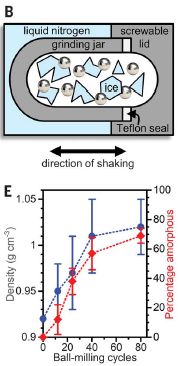
|
Start with part E (bottom). It shows some data. The blue curve shows the density of the ice (y-axis; left-hand scale) as treatment continues (x-axis). The density increases, from the usual density of ice (lower than that of liquid water) to about 1 g/cm3.
The red curve shows the percentage of amorphous ice (right-hand y-axis scale). We'll leave the explanation of that for now.
Part B (top) shows how the scientists did this. Ordinary ice was in a container cooled with liquid nitrogen (77 K). Steel balls were added, and the material was shaken back and forth -- vigorously. That's ball milling. The energy of the moving balls banging into the material affects it.
Ball milling leads to two effects. One is shearing of the ice into thinner layers. The other is compression.
This is part of Figure 1 from the article.
|
It is not entirely clear what is happening. There is more data, and some computer modeling. The sense is that the thin layers of ice released by ball milling are re-arranging into a denser form -- an amorphous (non-crystalline) ice about the same density as liquid water. The authors think its structure is very much like liquid water -- just now frozen in place. (But note, that is not how it is made; it is made from common crystalline ice, of low density.) They think it might be considered a glassy form of water.
Many kinds of ice are recognized, including at least two forms of amorphous ice. The authors refer to their new material as MDA ice, for medium-density amorphous ice. If nothing else, MDA ice fills a gap between the previously known amorphous ices of low and high density.
The density of MDA ice is a bit more complicated than the graph above suggests. The material tested there is a mixture. From the measured density and percent of MDA, the authors calculate that the density of MDA ice is 1.06 +/- 0.06 g/cm3.
The list of water-ices gets longer. And it continues to raise questions about the nature of water. Amorphous ices, perhaps including MDA, are likely to be geologically important, especially in ultra-cold environments beyond Earth.
Movies: There are two movie files posted with the article, as Supplementary Materials. The first shows much of the process of making MDA ice in the lab, and may be worth a look (9 minutes; narrated, by the lead author). Movie 2 outlines the computational modeling (2 minutes; music, but no narration).
News stories:
* Scientists discover a new type of ice that behaves like liquid water -- It's been described as "stop-motion water". (Tibi Puiu, ZME Science, February 3, 2023.)
* Discovery of new ice may change understanding of water. (Nanowerk News (University College London), February 4, 2023.)
The article: Medium-density amorphous ice. (Alexander Rosu-Finsen et al, Science 379:474, February 3, 2023.)
More ice:
* Why is ice slippery? (September 9, 2018).
* Ice in your diamond? (April 23, 2018).
More things glassy: Turning metal into glass (September 21, 2014).
Role of oxytocin in monogamy in prairie voles
May 22, 2023
Oxytocin fascinates both biologists and the general public. It is sometimes called the love hormone.
The prairie vole, Microtus ochrogaster, is a rodent with the rather uncommon property of being monogamous. And it is thought that oxytocin is a key part of what makes it monogamous. A variety of interventions to disrupt the oxytocin system reduce monogamy.
A recent article is causing people to re-examine the story. The article reports that prairie voles with a genetic disruption of their oxytocin receptor show normal monogamy.
The first figure introduces the test system. It shows one of the apparatuses used to test the voles.

|
The animal at the top is the one being tested. It has access to two other voles, each of which is constrained to remain in its own compartment. Those target voles are of the opposite sex to the test vole; one is the established partner of the test vole, and one is a stranger. The behavior of the test vole is observed.
This is Figure 3A from the article.
|
Here are some results...

|
Part C (top) shows the time the test vole spent "huddling" with one of the target voles. Each line is for one test vole. The bars summarize the results: the left bar of each pair is for the partner (clear bar); the right bar is for the stranger (shaded).
The left side of the figure is for male test voles; the right side is for females. The sex is labeled at the top.
For each sex, the left set of results is for wild type (WT) voles; the right side is for mutant voles -- with their oxytocin receptor disrupted. The strain is labeled at the bottom of the figure.
Big picture: The four sets are about the same. Most of the lines (for individual voles) are high to the left. That is, most of the animals spent more time huddling with their established partner than with a stranger -- regardless of their oxytocin receptor.
|
Part F (bottom) shows another set of observations using the same general system. In this case, the observation was attacks. And in this case, most of the lines are high to the right. That is, most of the animals were more likely to attack the stranger than their established partner -- regardless of their oxytocin receptor.
This is more of Figure 3 from the article.
|
The article contains other work comparing WT prairie voles with the mutants with disrupted oxytocin receptor. For example, parenting appeared to be normal in the mutant voles. (Mothers lacking the oxytocin receptor had limited ability to nurse, but their general behavior was normal.)
The work was done with three different mutant vole strains, and was done in multiple labs.
The general conclusion from this article would be that loss of the oxytocin receptor does not affect monogamy is these prairie voles.
That is directly contrary to previous work, using different manipulations of the oxytocin system. At this point, there is no explanation for the contradiction. (Some possible explanations are noted in the Discussion section of the article.) However, the two sides of the contradictory work lay the groundwork for experiments to resolve the contradiction. The love hormone may turn out to be more complicated than we had thought.
The article is also of interest for developing genetic tools for working with these interesting animals.
News stories:
* Fresh questions about oxytocin as the 'love hormone' behind pair bonding. (Robin Marks, University of California - San Francisco, January 27, 2023.)
* Prairie voles without oxytocin receptors can bond with mates and young. (EurekAlert! (Cell Press), January 27, 2023.)
* Prairie Vole Study Raises Questions on Role of Oxytocin in Social Attachment. (GEN, January 30, 2023.)
The article, which may be freely available: Oxytocin receptor is not required for social attachment in prairie voles. (Kristen M Berendzen et al, Neuron 111:787, March 15, 2023.)
More about oxytocin: Is the hormone of love also the hormone of discrimination? (January 29, 2011). Good background.
More voles (different kind): Unusual nature of CWD; implications for transmission to humans (September 24, 2022).
Effect of corticosteroids on brain function
May 20, 2023
Corticosteroids (glucocorticoids) are useful drugs (commonly as anti-inflammatory agents). However, they can have significant side effects, including effects on memory. The natural levels of such steroids fluctuate on a regular basis during the day (circadian rhythm), and there has been suspicion that the added steroid drugs interfere with the natural (endogenous) steroids.
A new article offers some clues about how the effect works. The work is in a rat model.
The article is complex; we'll just peek. The following figure shows a couple of pieces of evidence...
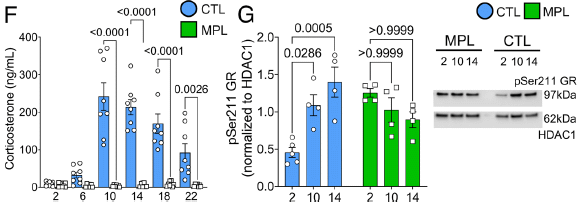
Part F (left) shows the levels of the natural steroid (y-axis) over time (x-axis). The green data are for treatment with the steroid drug (MPL = methylprednisolone); the blue data are for the control (CTL).
What's important is that the two sets of results are very different. The added steroid drug greatly affected the release of the natural steroid.
Can't see much green data? There is a green bar just to the right of each blue bar. Most of the green bars are very near zero, and largely covered with white dots.
The natural steroid in this case (rats) is corticosterone (see y-axis label). In humans, it would be cortisol.
You can take the x-axis scale as time in hours. The time is relative to a reference point in the circadian cycle. As an example, T = 10 corresponds to waking up.
Part G (right) shows the levels of a particular form of a steroid receptor in the brain. The right side of part G shows the raw data: the Western blots used to measure the levels of the receptor and a reference protein (HDAC1). The left side shows the results based on such Western blots in graphical form.
Again, the main point is that the green and blue results are very different.
This is part of Figure 1 from the article.
|
Overall, the article offers clues as to how the administered steroid affects the brain. Much of the work focuses on the hippocampus, a brain region associated with memory. (I skipped over details above, but part G of the figure is about gene function in the hippocampus -- affecting the circadian rhythm.) A simple point is to make clear that the memory effects seen with patients can be due to the added drug in healthy animals. Beyond that, understanding a drug better should open up new avenues for drug development.
News story: Long-Term Use of Steroids Could Impair Memory. (Neuroscience News (University of Bristol), April 16, 2023.)
The article, which is open access: Circadian regulation of hippocampal function is disrupted with corticosteroid treatment. (Matthew T Birnie et al, PNAS 120:e2211996120, April 6, 2023.)
A recent post about circadian rhythms: Daylight savings time: night-owls have more difficulty adapting (August 1, 2021). Links to more.
A post about another such steroid drug: Briefly noted... 1. Dexamethasone: first drug shown to reduce mortality due to COVID-19 -- and an important caveat (July 1, 2020).
More about brains is on my page Biotechnology in the News (BITN) -- Other topics under Brain. It includes a list of related Musings posts.
May 17, 2023
Briefly noted... New genes -- which have arisen "recently" in the human lineage
May 17, 2023
Microproteins are very small proteins -- small enough that it can be hard to be sure they are real functional proteins just from genome information. A recent article explores microproteins in the human and other vertebrate genomes, and shows that evolution is quite active. There is good evidence that numerous microproteins have arisen within the vertebrate lineage; a few have arisen within the human lineage since the split from other primates. In particular, the scientists find genes that that arisen de novo, not by duplication of existing genes. For some, there is evidence about their function. In general terms, it's a fun story. Just try to avoid getting bogged down in genomic details.
* News story: Humans continue to evolve: Study tracks the emergence of 155 new genes. (Phys.org (Cell Press), December 20, 2022.)
* The article, which is open access: De novo birth of functional microproteins in the human lineage. (Nikolaos Vakirlis et al, Cell Reports 41:111808, December 20, 2022.)
* More about genome analysis is on my page Biotechnology in the News (BITN) - DNA and the genome.
Briefly noted... A hydrogen-powered comet?
May 16, 2023
The comet 'Oumuamua has fascinated astronomers since its discovery in 2017. Its behavior just doesn't fit. A recent article offers a new proposal to explain its unusual orbit. The key points are:
- In interstellar space it was bombarded by cosmic rays, which led to dissociation of water just below the cometary surface. The resulting hydrogen gas was retained within the comet.
- When it got near the Sun, the H2 heated up and was forced out, effectively serving as a rocket -- changing the orbit.
There is no way to know for sure whether this is correct, but one prediction is that we might observe similar orbital (mis)behavior for Solar System comets, if only we find some of this tiny size.
* News story: Surprisingly simple explanation for alien comet 'Oumuamua's weird orbit. (Robert Sanders, University of California - Berkeley, March 22, 2023.) Excellent overview.
* News story accompanying the article: Astronomy: A compelling explanation for an enigmatic object -- Seemingly contradictory observations of the first known interstellar object are reconciled in a model that presents a simple and physically realistic framework for understanding the object's many peculiarities. (Marco Micheli, Nature 615:591 March 23, 2023.)
* The article: Acceleration of 1I/'Oumuamua from radiolytically produced H2 in H2O ice. (Jennifer B Bergner & Darryl Z Seligman, Nature 615:610 March 23, 2023.)
* 1I/'Oumuamua was mentioned in the post Briefly noted... 1. Visitors from beyond the solar system. (December 11, 2019).
* Previous post about hydrogen: Storing hydrogen in magnesium diboride nanosheets (May 15, 2023). Immediately below.
Storing hydrogen in magnesium diboride nanosheets
May 15, 2023
A recent article reports an interesting development in storing hydrogen. The following figure shows some results...
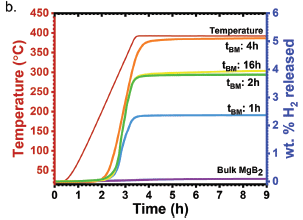
|
The figure actually shows the release of H2 from various materials; that release is intended to reflect how much was present. Release is measured over several hours (x-axis); it is shown on the right-hand y-axis scale, as weight %.
The temperature (T) is raised during the first three hours, from ambient to nearly 400 °C. The top curve shows the T profile over time; see the left-hand y-axis scale.
|
The starting material was magnesium diboride, MgB2. It is known that one can store H2 in MgB2, but the amount of H2 stored is small in practice.
The bottom curve shows release of H2 from "bulk MgB2" that had been "filled" with H2. It is near zero.
The other four curves are for variations of the material developed in the current work. They are all labeled "BM", for ball-milled. These materials give 2-5% H2 -- far more than the "bulk MgB2" shown in the bottom curve. (They vary in the time of ball milling; it seems that 4 hours is optimal.)
This is Figure 6b from the article.
|
That is, they have enhanced the H2-capacity of the MgB2 -- by a lot (about 50-fold). (Even 2% H2 is good.)
It is likely that the hydrogen is being stored in the material largely as magnesium borohydride, Mg(BH4)2. That chemical is about 15% hydrogen. (The hydrogen content of octane, symbolic of gasoline, is also about 15%.)
How did they achieve this improvement? As noted above, the material was ball-milled. The improvement in H2-capacity is largely due to reducing the MgB2 to very small pieces. That increases the surface available for binding. There is more to the story, but that's a good start.
The following figure shows the stuff...
Part c (left) shows some of it, based on atomic force microscopy. The pieces are about 1 µm across -- and very thin.
Part d (right) shows measurements of the thickness for one piece: about 4 nm for most of it. That is about 12 atoms thick.
This is part of Figure 2 from the article.
|
It seems likely that hydrogen storage is restricted to the first two atomic layers on each side. That would be four of the 12 layers in the 4 nm material. That is consistent with getting about a third of the theoretical capacity.
It's not new to store hydrogen in metal-based structures, including those with boron. However, working out practical ways to do it has proved challenging. The current work offers good storage and release under reasonable conditions. Reducing the particle size, thus increasing the surface area, is a key step here. The scientists see potential for further progress.
News story: Going small and thin for better hydrogen storage. (Phys.org (Lawrence Livermore National Laboratory), February 7, 2023.)
The article: Hydrogen Storage in Partially Exfoliated Magnesium Diboride Multilayers. (Harini Gunda et al, Small 19:2205487, February 8, 2023.)
More about hydrogen storage: Storing hydrogen in salts (such as potassium formate) (November 7, 2022).
Added May 16, 2023.
Next post about hydrogen: Briefly noted... A hydrogen-powered comet? (May 16, 2023). Immediately above.
There is more about energy issues on my page Internet Resources for Organic and Biochemistry under Energy resources. It includes a list of some related Musings posts.
Should bags be made from torrefied paper?
May 14, 2023
Good idea, according to a recent article.
Here's why...
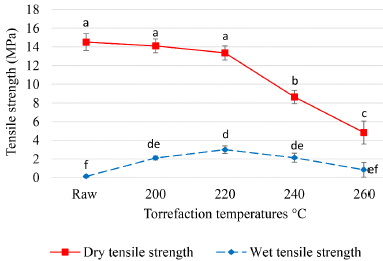
|
The graph shows the strength of pieces of filter paper -- wet and dry, with various treatments.
The points at the left are for untreated paper, labeled here as "raw". The strength is about 14 MPa dry (red point) and about zero wet (blue). Paper is not strong when wet; you knew that.
The rest of the points are for paper that has been torrefied -- at various temperatures (T), shown on the x-axis. For the first two points (200 and 220 °C), there is little effect on the dry strength, but a significant improvement in wet strength.
|
You can't tell from that graph, but the improvement in wet strength is about 20-fold at the peak (220 °C; see Table 1 of the article). The wet strength is about 20 % of the dry strength. Not bad. In fact, it is good enough that the paper would be classed as "wet-strong".
The letters on the points identify points that are statistically not different. For example, the first three points on the dry curve (red) are all labeled "a". They are not statistically different. The middle three points on the wet curve (blue) are all labeled "d". They are not statistically different.
This is Figure 3 from the article.
|
It's an interesting finding, which could lead to improved paper bags -- better able to tolerate getting wet.
What is this torrefaction? It's basically a dry heat treatment, or "roasting", in an inert atmosphere. It serves to bind things together in the paper. The authors had previously shown that it makes lignocellulose more hydrophobic; that led them to ask if it would have a similar effect on paper, which is nearer to pure cellulose.
The torrefaction has a downside. It is harder to digest the torrefied paper, perhaps for the same reason it is stronger. Thus it would be harder to recycle at the end of its useful lifetime. (Imagine that the paper is to be digested to glucose, and converted to biofuel.) The following figure shows that -- and shows a solution.
The y-axis shows the amount of glucose obtained by ordinary hydrolysis of the paper.
The green bars are for the various papers discussed above, with no special treatment for hydrolysis. The "raw" paper gave about 1000 mg glucose per gram of paper. For simplicity, let's call that 100% recovery. But the recovery dropped off for torrefied paper. It was down to about 30% at the torrefaction T that gave the optimum wet strength, and declined even further at higher torrefaction T. It is clear that the torrefaction, which increases wet strength, decreases the digestibility.
|
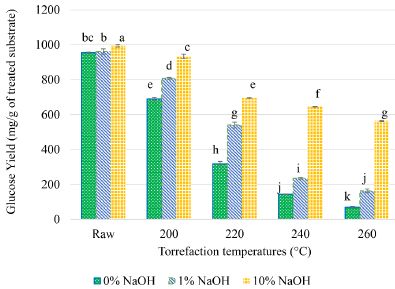
|
Now look at the yellow bars. Much better than the green bars; about 70% recovery at the T that gave the best wet strength.
The treatment (yellow bars) is 10% sodium hydroxide.
The blue bars are for a milder version of the treatment; it gave an effect, but a smaller one.
This is Figure 5 from the article.
|
The work offers leads about making paper bags that can better withstand getting wet, and still serve as a sugar source for making biofuel at the end of their useful life as bags. The authors are clear that they have not done thorough economic analyses.
The article also introduces a technique that may well be new to you.
News stories:
* Stronger paper bags could be the answer to throwaway plastic -- A simple technique to make paper bags stronger, even when wet, would make them more reusable - and they can still be used for biofuel at the end. (Prachi Patel, Anthropocene, May 4, 2023.) (The story refers to the glucose content of the paper. What was actually measured was the recovery of glucose from the paper, which is somewhat distinct.)
* Stronger paper bags - reused repeatedly then recycled for biofuel - could be the future. (Tech Xplore (Jeff Mulhollem, Pennsylvania State University), April 19, 2023.)
The article: Torrefied paper as a packaging material and subsequently as a bioethanol substrate: Synergy of torrefaction and alkaline treatment for increased utility. (Jaya Tripathi et al, Resources, Conservation & Recycling 191:106882, April 2023.)
Previous posts about torrefaction: none.
More bags (posts with 'bag' in the title):
* Lamb-in-a-bag (July 14, 2017).
* What if the caterpillars ate through the plastic grocery bag you put them in? (May 26, 2017)
* Possible transmission of norovirus via reusable grocery bag (May 21, 2012).
* How to fold a bag (May 13, 2011).
May 10, 2023
Briefly noted... Do fighter pilots suffer the same problems that astronauts do?
May 10, 2023
Gravity affects astronauts and flies. And fighter pilots, according to a recent article.
* News story: Brain changes in fighter pilots may cast light on those experienced by astronauts during space travel. (Medical Xpress (Frontiers), February 15, 2023.)
* The article, which is open access: Neuroplasticity in F16 fighter jet pilots. (Wilhelmina E Radstake et al, Frontiers in Physiology 14:1082166, February 15, 2023.)
* Background: Improving health in space: add a little gravity (December 3, 2022). Links to more.
Why bears don't get blood clots during hibernation
May 9, 2023
If people sit too long, they can get blood clots in their veins. The condition is called deep vein thrombosis. The clots can be fatal. Some people may be at increased risk for forming such clots.
You might wonder, then, do bears that hibernate over the winter get such blood clots? After all, they are nearly motionless for months.
They do not. A new article explores why.
You might wonder, then, if the answer has any relevance to humans. Bear with us for a bit; we'll come back to that.
The main work in the article was to compare active and hibernating bears. Turns out, blood clotting in hibernating bears is different; the blood platelets became the focus of attention.
To get further detail, the scientists looked at protein levels in the platelets of active and hibernating bears. The following figure summarizes the results -- and points to a candidate of interest...
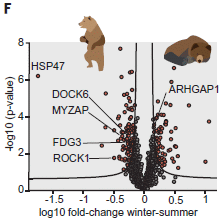
|
The figure shows the level of many proteins in the blood platelets in bears, summer vs winter (that is, active vs hibernating). It's a simple idea, but the presentation here is not so simple.
Look at the point near the upper left, labeled HSP47. That's the protein of interest, and we'll just explain what this graph shows about it.
The x-axis shows the change in amount, summer vs winter. Negative values, such as for our chosen point, mean the protein is more abundant in the summer.
|
The y-axis shows the statistical significance of the finding that the protein level depends on the season. As usual with p values, small p is better -- and small p are at the top of the y-axis scale.
Both axes are log-scale. The y-axis scale is "inverted'; it is -log that is plotted.
Our chosen point has the largest effect seen for any protein shown here. It is much less abundant in hibernating bears, by more than a factor of 10 (which is -1 on the scale). The p value for the significance of the finding is one of the best (smallest) p value shown (below 10-6).
This is Figure 2F from the article.
|
What is this HSP47 protein? HSP means it is a heat-shock protein. But more to the point, it is known to play a role in blood clotting. Thus it appears that bears shut down a gene involved in blood clotting when they hibernate.
The scientists then looked at parts of the story in other mammals, using various tools; HSP47 is involved in blood clotting for all they examined. Pigs, mice, and ...
What about humans? We said that people who sit for extended periods may develop blood clots. However, there are known exceptions. For example, people who are paralyzed, unable to move their limbs, do not develop blood clots.
The following figure looks at the level of HSP47 protein in people with such paralysis...
The figure shows results from immunoblots, to measure the level of HSP47 protein in platelets. Actin is measured as a control; it should be the same for all people.
The two people shown at the left are normal, as controls. The two people at the right are paralyzed, due to SCI = spinal cord injury.
|

|
You can see that the paralyzed people have lower levels of HSP47.
This is Figure 5C from the article.
|
Results for more people are shown in the article. Results vary, but certainly paralyzed people tend to have lower levels of HSP47.
In a separate study, people kept bedridden (for other reasons) began to show lower levels of HSP47 after about a month of inactivity. This suggests a natural process is at work, though its basis is unknown at this point.
One implication of the work is that inhibiting HSP47 might be a tool in reducing unwanted blood clotting. That is, inhibiting HSP47 may be a target for drug development.
Hibernating bears and paralyzed people share a feature, and that finding could lead to a drug development. It's an interesting article.
News stories:
* Rethinking What it Means to Sleep Like a Bear. (Science in the News (Harvard), May 4, 2023.)
* Humans, and piglets, and bears, oh my! Preventing dangerous blood clots. (Medical Xpress (University of Reading), April 13, 2023.)
* The paradox of thrombosis: Determining how hibernating bears and paraplegics avoid blood clots. (Phys.org (Max Planck Society), April 14, 2023.)
* News story accompanying the article: Medicine: Sleep like a bear -- Reduced expression of a platelet protein protects against thrombosis during chronic immobilization. (Mirta Schattner, Science 380:133, April 14, 2023.)
* The article: Immobility-associated thromboprotection is conserved across mammalian species from bear to human. (Manuela Thienel et al, Science 380:178, April 14, 2023.)
More about hibernating bears: Bears hibernate -- but stay warm (April 30, 2011).
More about blood clotting:
* Is erythritol a toxic sweetener? (April 8, 2023). This post and the current one both deal with the interaction of platelets and collagen, and the role of that interaction in clotting.
* COVID and cardiovascular events (blood clots) (October 3, 2022).
* Mechanism of blood clotting: how the von Willebrand factor works (May 18, 2021). Links to more.
How to make a mummy
May 7, 2023
A new article reports the most extensive analysis yet of how to make mummies. The work was done at an ancient Egyptian embalming workshop. The scientists were able to analyze workshop materials, such as the contents of specific pots. They could also read the labels on the pots, which sometimes included instructions as well as identifying the materials. Having both materials and words let them put together a story. That is, the article is about analyzing the mummification process, not just the final product.
It's a fascinating study, though there is not much in the way of good pictures. We'll just note some highlights here. For those who want more, the news stories are good at overview. Then there is much technical information in the article, for those who thrive on chromatograms.
The following figure is part of a summary in the article...

|
The figure gives an idea of some points that came up.
There is no need to pay attention to any particular details.
The analysis is from an embalming workshop at Saqqara, in Egypt. The materials analyzed here date back to about 600 BC. The burial site itself dates back another two millennia. Thus there is much history behind the materials analyzed here -- much time to develop methodology that works, simply based on experience.
This is the left-hand part of Figure 4 from the article.
|
Comments...
Some of the materials used were not available locally. It seems that international trade was needed for mummification. (One section of the article is labeled "Egyptian mummification and the world economy" (p 292).)
Being able to match words and chemicals from the same pot helped the scientists with some translations. This will allow for re-interpretation of some earlier wok, where the meaning of some terms was not clear.
The site studied here was discovered less than a decade ago; it is the first ancient embalming workshop to be identified. The discoverer of the site is an author of the current work, though he died before publication.
News stories:
* How to make a mummy: Ancient Egyptian workshop has new clues. (Maddie Burakoff, Phys.org, February 1, 2023.)
* Ancient Egyptian embalmers were savvy chemists. (Patricia Contreras Tejada, Advanced Science News, February 14, 2023.)
* The chemistry of mummification - Traces of a global network. (University of Tübingen, February 1, 2023.)
* News story accompanying the article: Archaeology: Recipes for ancient Egyptian mummification -- What ingredients and processes underlay mummification in ancient Egypt? The molecular analysis of labelled pots excavated from an embalming workshop provides some answers to this question. (Salima Ikram, Nature 614:229, February 9, 2023.)
* The article, which is open access: Biomolecular analyses enable new insights into ancient Egyptian embalming. (Maxime Rageot et al, Nature 614:287, February 9, 2023.)
Posts about mummies include...
* The oldest known piece of cheese (April 25, 2014).
* A new approach for testing a Llullaillaco mummy for lung infection (August 17, 2012).
* Diagnosis of prostate cancer in a 2100 year old man (November 8, 2011).
Also see: Libyan desert glass, King Tut, and the hazards of meteorite strikes (May 31, 2019).
May 4, 2023
Paint without pigment
May 4, 2023
The following figure shows two examples of color in biology. The figure is from a recent article, presented there as background.
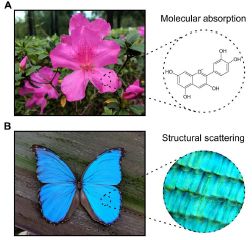
|
Part A (top) shows flowers from Formosa azaleas. The color is due to a pigment: a chemical that absorbs part of the light spectrum, leaving only red to be reflected.
Part B (bottom) shows a butterfly, Morpho didius. The color is due to the physical structure. A regular pattern results in certain wavelengths being scattered.
This is part of Figure 1 from the article.
|
That illustrates two ways to get color. The first, using "molecular absorption" by pigments to absorb some wavelengths out of the spectrum, is perhaps more familiar. We have learned more and more about the second, sometimes called structural color, in recent years.
Paint is commonly based on pigments -- the first approach. Can we make paint based on structural color? That is exactly what the new article reports.
Look...
Part A (left) shows a field the authors have planted with artificial butterflies. Various colors -- all painted with versions of the new paint, based on structural color.
The two parts at the right show that the color is robust. The photos here are of the same butterfly, with various types of polarization of the light (B) and various viewing angles (C). Looks good. Designing these features into the new paint was part of the development reported here.
This is part of Figure 4 from the article.
|
The paint is made from aluminum and aluminum oxide. Making new colors just means organizing them differently.
The new paint also reflects infrared light very well. It thus leads to cooling of whatever it coats.
The paint is lightweight. Only about 0.4 g paint is needed to cover a square meter of surface. The authors estimate that it would take about three pounds of their paint to cover a jet airplane (Boeing 747) -- down from about a thousand pounds now. That is enough of a difference to result in meaningful fuel savings. Further, the new paint should be quite long-lived.
So far, the new paint has been made only at lab scale. However, the authors think the process can be developed at industrial scale.
News stories:
* Scientists Create World's Lightest Paint: Just 3 Pounds Covers a Boeing 747. (Fiona MacDonald, Science Alert, March 31, 2023.)
* UCF Researcher Creates World's First Energy-saving Paint - Inspired by Butterflies. Instead of pigment-based colored paint, which requires artificially synthesized molecules, a UCF researcher has developed an alternative way to produce colored paint that is more natural, environmentally friendly and light weight. (Katrina Cabansay, University of Central Florida, March 8, 2023.)
The article, which is open access: Ultralight plasmonic structural color paint. (Pablo Cencillo-Abad et al, Science Advances 9:eadf7207, March 8, 2023.)
A recent post about paint: A lightweight white paint (January 23, 2023).
More about structural color: How to "dye" carbon fiber -- with titanium dioxide (January 20, 2018).
Update added October 27, 2023.
Scientists now report a paint that can remove carbon dioxide from the air and produce oxygen. The approach is to include photosynthetic bacteria (cyanobacteria) in the paint. Finding a suitable strain was an interesting and non-trivial task.
* News story: 'Green living paint' produces oxygen and captures carbon dioxide. (Paul McClure, New Atlas, October 18, 2023.)
* The article, which is open access: Oxygen evolution from extremophilic cyanobacteria confined in hard biocoatings. (Simone Krings et al, Microbiology Spectrum 11:01870-23, September 2023.)
Briefly noted... Viruses and Alzheimer's disease (and other neurodegenerative diseases)?
May 3, 2023
A new article reports examination of two national databases of medical information looking for associations between viral infections and various neurodegenerative diseases, including Alzheimer's disease. For this purpose, "viral infections" meant those serious enough to result in hospitalization. Several associations were found. What is important for now is to emphasize that these are statistical correlations, with no evidence for causality. Such results are intriguing, and serve as leads for further investigation.
* News story: Could a viral illness increase chances of developing Alzheimer's or other neurodegenerative disease? (Medical Xpress (NIH), January 25, 2023.)
* The article, which is open access: Virus exposure and neurodegenerative disease risk across national biobanks. (Kristin S Levine et al, Neuron 111:1086, April 5, 2023.)
* My page for Biotechnology in the News (BITN) -- Other topics has a section on Alzheimer's disease. It includes a list of related Musings posts.
Artificial exercise, using a robotic device glued to the muscle
May 2, 2023
Muscles can atrophy (degrade) if not used. Sometimes, a medical condition may preclude ordinary muscle use.
Perhaps we could exercise muscles artificially. Perhaps we could attach a robot to a muscle, to exercise it.
The following figure shows such a system, from a recent article...
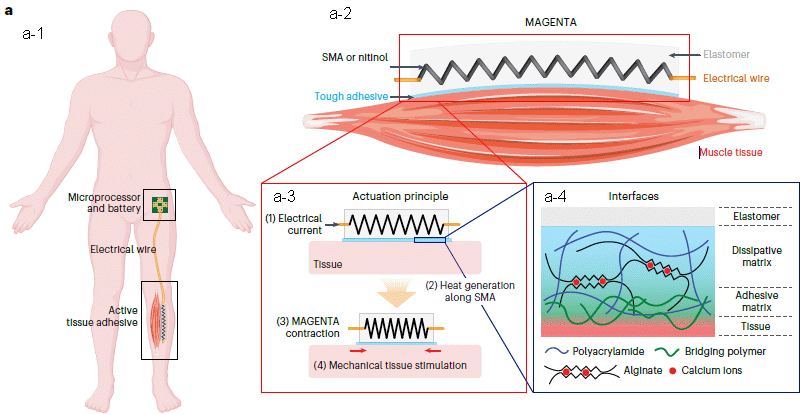
The left-hand part (labeled a-1 at the upper left) shows the big picture. There is an "active tissue adhesive" glued to a muscle in the leg. It is connected by a wire to "microprocessor and battery". That is a controller, which provides instructions and power.
The view at the top right (a-2) shows the device attached to a muscle. In particular, note the black zig-zag line; it is a piece of memory metal, which can be flexed by heat. The flex-metal is embedded in a flexible shell labeled here as "elastomer". That is attached to the muscle by a "tough adhesive".
- The device is called MAGENTA, for mechanically active gel-elastomer-nitinol tissue adhesive.
- The flex-metal is labeled "SMA or nitinol". SMA = shape memory alloys. Nitinol is a specific example, used in the work here.
Below that to the left (a-3)... the "actuation principle". When the flex-metal is heated (by electricity), it contracts. Because the metal is effectively attached to the muscle, contraction of the metal drives contraction of the muscle. When the heat input to the metal is removed, the process reverses.
At the lower right (a-4) is an expanded view of the "interfaces". In particular, note the alginate chains, cross-linked by calcium ions; those chains couple flex-metal-in-elastomer with muscle tissue.
This is Figure 1a from the article. I have added labels, such as a-1, at the upper left of each part, to aid in referring to them.
|
Does it work? The following figure shows some data...
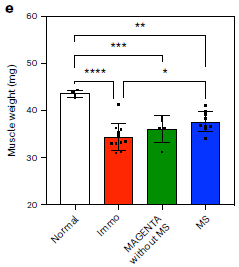
|
The graph shows muscle weight under four conditions, with mice. From the left...
* (white) Normal (control) muscles.
* (red) Immo = immobilized. The muscles have wasted away some. This represents the condition to be treated. Untreated control.
* (green) MAGENTA attached, but without mechanical stimulation (MS).
* (blue) MS. The full treatment: device with stimulation.
You can see that the results for the full treatment (blue) are better than for the untreated control (red). The * (above the line connecting them) indicates statistical significance.
This is Figure 5e from the article.
|
If you have concerns about the conclusion or other observations, we will just note that the article contains other results that generally support the point: the treatment with MAGENTA stimulation helped reduce muscle atrophy.
Overall, the work is encouraging. It should lead to further testing and development for specific situations in humans.
News stories:
* Scientists develop mechanically active adhesive that prevents muscle loss -- The device constantly stretches and contracts immobilized muscles to prevent muscle loss. (Tibi Puiu, ZME Science, November 23, 2022.)
* Wasting muscles built back better -- Programmable mechanically active adhesive makes muscles stretch and contract, preventing and enabling recovery from atrophy. (Benjamin Boettner, Wyss Institute (Harvard), November 14, 2022.)
* News story accompanying the article: Tissue regeneration: A bioadhesive robot to activate muscles -- Soft actuators composed of a tough bioadhesive/elastomer shell encapsulating a stimuli-responsive metallic spring provide in situ mechanical stimulation of skeletal muscles to promote muscle tissue rehabilitation and prevent atrophy. (Xuanhe Zhao, Nature Materials 22:149, February 2023.)
* The article: Active tissue adhesive activates mechanosensors and prevents muscle atrophy. (Sungmin Nam et al, Nature Materials 22:249, February 2023.)
Other posts about muscle include... Making better artificial muscles (March 13, 2018). Links to more.
Among posts about exercise...
* Effect of exercise on developing ALS (July 27, 2021).
* How exercise benefits the brain (August 9, 2020).
There is more about regeneration and related topics on my BITN page for Cloning and stem cells. It includes two extensive lists of related Musings posts.
Top of page
The main page for current items is Musings.
The first archive page is Musings Archive.
E-mail announcement of the new posts each week -- information and sign-up: e-mail announcements.
Contact information
Site home page
Last update: March 13, 2024














